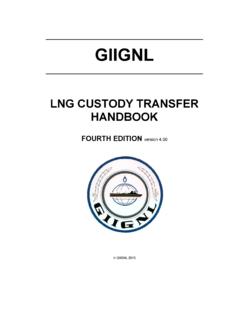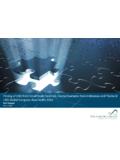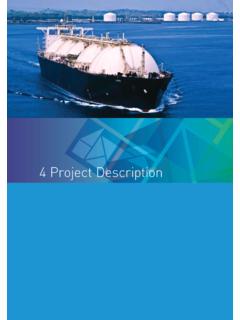Transcription of Basic Properties of LNG - giignl.org
1 1 Information Paper No. 1 Basic Properties of LNG GIIGGIIGNL s Technical Study Group has overseen the development of this Information Series of seven papers to provide factual information about liquefied natural Gas (LNG). In French, Spanish, Portuguese, or Italian speaking countries, the abbreviation GNL is used in place of LNG. This paper begins with a review of Basic LNG Properties , which is a pre-requisite for accurately assessing potential LNG safety hazards and risks. For more information on these topics, additional references and weblinks are provided at the end of this paper. Introduction: A Basic knowledge of LNG must begin with an examination of its chemical and physical Properties . Chemical and physical Properties are fundamental to understanding LNG correctly.
2 The very Properties which make LNG a good source of energy can also make it hazardous if not adequately contained. These Properties determine how LNG behaves, affect our predictions about its behaviours, and influence how we assess and manage safety risks. Furthermore, to accurately understand and predict LNG behaviour, one must clearly distinguish its Properties as a liquid from its Properties as a gas or vapour. The reader will note that discussions of the Properties of LNG often contain ominous caveats like depending upon its exact composition because such specifics matter. It is inexact and inappropriate to make universal generalisations about LNG. It is especially important to be clear in thinking through how LNG would behave if accidentally or intentionally released ( , from a terrorist attack), because the outcome would be profoundly influenced by the actual situation and site-specific conditions.
3 Misunderstanding LNG is not uncommon and is often caused by confusion, incomplete, or inaccurate information about LNG Properties . Since Properties determine behaviour and influence how we manage potential safety hazards and risks, having an accurate understanding is key. A number of LNG companies have made commitments to educate the general public about their product. For example, companies in Japan and South Korea have gone to great lengths to share information about their facilities with the local communities and to educate them about LNG. For example, Osaka Gas Company and Tokyo Gas Company have installed Gas Science Museums at each of their terminals; the first one opened in 1982. More than 50,000 children, among other visitors, tour the museums every year and are able to observe table-top demonstrations of LNG Properties and behaviours.
4 LNG is natural gas which has been converted to liquid form for ease of storage or transport. LNG takes up about 1/600th of the volume of natural gas. Depending upon its exact composition, natural gas becomes a liquid at approximately -162 C (-259 F) at atmospheric pressure. LNG s extremely low temperature makes it a cryogenic liquid. Generally, substances which are -100 C (-48 F or less) are considered cryogenic and involve special technologies for handling. In comparison, the coldest recorded natural temperatures on earth are C (-129 F) at the height of winter in Antarctica and the coldest reported temperature in a town was recorded in Basic Properties of LNG Basic Properties of LNG LNG Information Paper No. 1 2 Information Paper No.
5 1 Basic Properties of LNG Oymayakon (Sakha Republic) during Siberian winter ( C; F). To remain a liquid, LNG must be kept in containers which function like thermos bottles they keep the cold in and the heat out. The cryogenic temperature of LNG means it will freeze any tissue (plant or animal) upon contact and can cause other materials to become brittle and lose their strength or functionality. This is why the selection of materials used to contain LNG is so important. LNG is odourless, colourless, non-corrosive, non-flammable, and non-toxic. natural gas in your home may have been liquefied at some point but was converted into its vapour form for your use. The reason the natural gas you use in your home has a smell is because an odorising substance is added to natural gas before it is sent into the distribution grid.
6 This odour enables gas leaks to be detected more easily. Key liquid and gas Properties for LNG are: Chemical Composition, Boiling Point, Density and Specific Gravity, Flammability, and Ignition and Flame Temperatures. These Properties are listed on Material Safety Data Sheets (MSDS s). [Control Right click here to View MDSD.] Chemical Composition: natural gas is a fossil fuel, meaning it has been created by organic material deposited and buried in the earth millions of years ago. Crude oil and natural gas constitute types of fossil fuel known as hydrocarbons because these fuels contain chemical combinations of hydrogen and carbon atoms. The chemical composition of natural gas is a function of the gas source and type of processing. It is a mixture of methane, ethane, propane and butane with small amounts of heavier hydrocarbons and some impurities, notably nitrogen and complex sulphur compounds and water, carbon dioxide and hydrogen sulphide which may exist in the feed gas but are removed before liquefaction.
7 Methane is by far the major component, usually, though not always, over 85% by volume. Table 1 displays the chemical compositions of the hydrocarbon compounds which make up natural gas, and the volume ranges in which they may be present in LNG. Pipeline natural gas may contain small amounts of water vapour. LNG is often confused with liquefied petroleum gas (LPG), which in turn is often incorrectly identified as propane. In fact, LPG is a mixture of mainly propane and butane gases that exist in a liquid state at ambient temperatures Table chemical composition of LNG (Source: Center for Energy Economics, ) Chemical Chemical Formula Low High Methane CH4 87% 99% Ethane C2H6 <1% 10% Propane C2H8 >1% 5% Butane C4H10 >1% >1% Nitrogen N2 1% Other Hydrocarbons Various Trace Trace when under moderate pressure (less than MPa or 200 psi).
8 In the , Canada, and Japan, LPG consists primarily of propane (Table 2; next page). However, in many European countries, the propane content in LPG can be as low as 50% or less. Moreover, in some countries, LPG may contain a substantial portion of propylene. LPG s differing composition and physical Properties (from LNG) make its behaviour different as well. The propane and butane in LPG have different chemical compositions from methane, the primary hydrocarbon in natural gas and LNG. Propane and butane can be stored and transported as a mixture, or separately. Both are gases at normal room temperature and atmospheric pressure, like methane, readily vaporising. Propane liquefies much more easily than LNG (at -43 C [-46 F] vs.)
9 -162 C [-259 F] for LNG) so it is substantially easier to compress and carry in a portable tank. In fact, LPG is stored as a liquid under pressure at ambient (room) temperatures, whereas LNG is stored as a liquid only at very low temperatures and ambient pressure. Boiling Point: Boiling point is one of the most significant Properties because it defines when gas becomes a liquid. Webster-Merriman on line ( ) defines boiling point as the temperature at which a liquid boils or at which it converts rapidly from a liquid to a vapour or gas at atmospheric pressure. The boiling point of pure water at atmospheric pressure is 100 C (212 F). The boiling point of LNG varies with its Basic composition, but typically is -162 C (-259 F). 3 Information Paper No.
10 1 Basic Properties of LNG When cold LNG comes in contact with warmer air, water, or the environment, it begins to boil at that interface because the surrounding temperatures are warmer than Table 2. Typical composition of LPG in % by volume (Source: ) Country Propane Butane Belgium 50 50 France 35 65 Ireland 100* 100* Italy 25 75 Germany 90 10 UK 100* 100* Denmark 50 50 Greece 20 80 Netherlands 50 50 Spain 30 70 Sweden 95 5 * NOTE: In Ireland and the , LPG may be 100% of either Basic gas. the LNG s boiling point, as shown in Figure 1. Table 3 shows the boiling points of water and common gases. The liquefaction process cools natural gas to change it to a liquid which reduces the volume occupied by the gas by approximately 600 times. LNG is converted back into natural gas for distribution to industrial and residential consumers.







